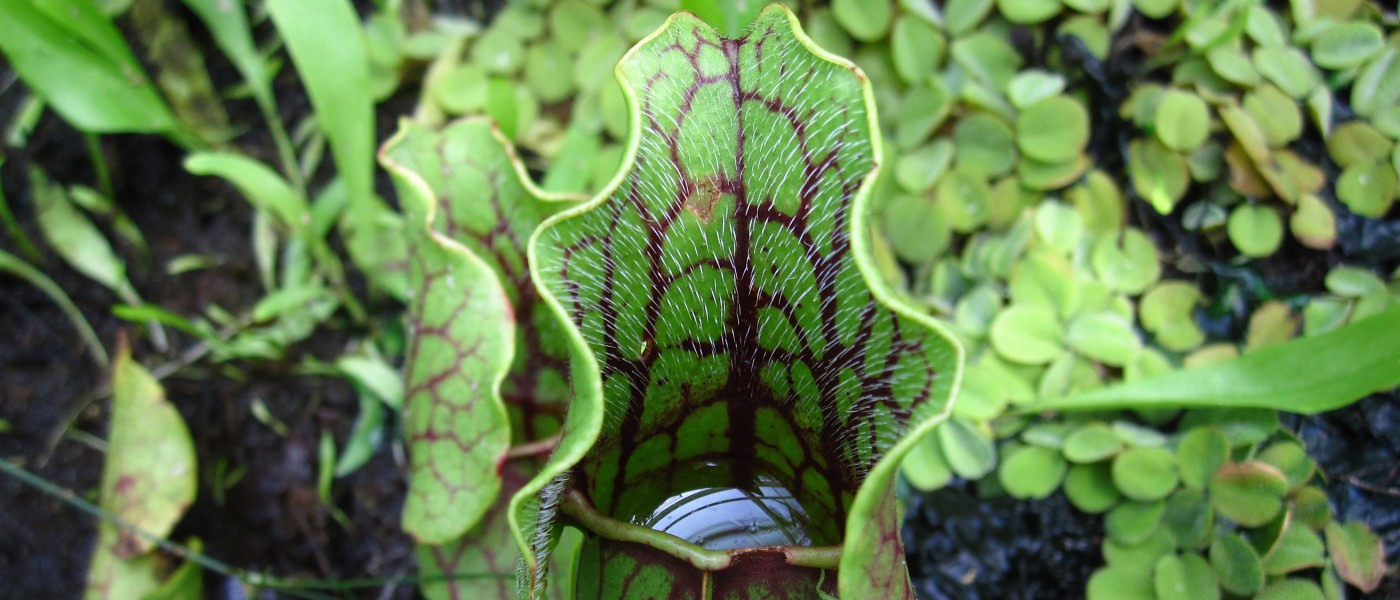Sarracenia: Native Pitcher Plants
One of the most intriguing groups of flowering plants in the plant kingdom is that of the carnivores. Eastern North America is home to the greatest diversity of carnivorous plants in the world, and the pitcher plants of the genus Sarracenia alone include eight known species and several subspecies, with many naturally occurring and cultivated hybrids.
Though most pitcher plants grow in the Southeast, the purple pitcher plant (Sarracenia purpurea) is a striking New York native that can be easily grown in the right conditions. Pitcher plants are usually found growing in areas with damp or wet, nutrientpoor soils such as peat bogs. They have adapted to obtain the nutrients necessary for their growth from prey that fall into their traps and are subsequently digested via special enzymes. Pitcher plants are sometimes referred to as insectivorous—and insects do make up the majority of a pitcher plant’s “diet”—but the more accurate term is carnivorous, because any small creature, insect or otherwise, that gets lured into a trap and can’t escape will eventually be consumed by the plant. The skeletal remains of small rodents, birds, frogs, and other animals have been found inside the tubes of pitcher plants!
The funnel-shaped tubes, or pitchers, of these plants make them conspicuous as carnivores: These are leaves modified over millions of years to form pitfall traps for prey attracted by the plant’s nectar and likely also by the highly decorative red-colored venation of the pitcher’s hood or lid. On the external surface of the pitchers are numerous glands that secrete insect-attracting nectar. Higher concentrations of nectar are secreted around the outward-curved margin at the opening of the tube as well as across the inner surface of the hood and within the trap itself. The cells that make up the hood have rigid, downward-protruding filaments that direct insects toward the opening of the pitcher.
An insect drawn to the opening will often hang from its hind legs in an attempt to access nectar far inside the pitcher. The downward-pointing hairs make it difficult for the insect to maintain stable footing, often resulting in a fatal slip and plunge into the depths of the trap. Just below the line of hairs arranged around the opening, the inner wall of the pitcher has a waxy smooth surface that makes it nearly impossible for an insect to climb out of the trap. Specialized glands within the tube release digestive enzymes that intoxicate and anesthetize the prey as they break down its body to release precious nutrients that are then absorbed by the plant. For successful cultivation, pitcher plants require full sun exposure and a nutrient-poor soil that is highly moisture retentive, such as a 1-to-1 or 2-to-1 mix of peat moss and coarse sand.
Containers should be placed in deep drainage saucers and watered at least every other day so that the soil is never allowed to dry out completely. Pitcher plants are best grown outdoors, where they can receive adequate sunlight and attract prey. All species of Sarracenia are highly ornamental and fascinating to grow by children and adults alike. Specimens should not be collected from the wild, because many pitcher plants plants, like their habitats, are delicate and endangered. Many species and hybrids are available for purchase online or at specialized nurseries, and some can even be grown from seed. Cultivating a pitcher plant of your own can be quite gratifying and helps to ensure the success and survival of this wonderful native plant.


